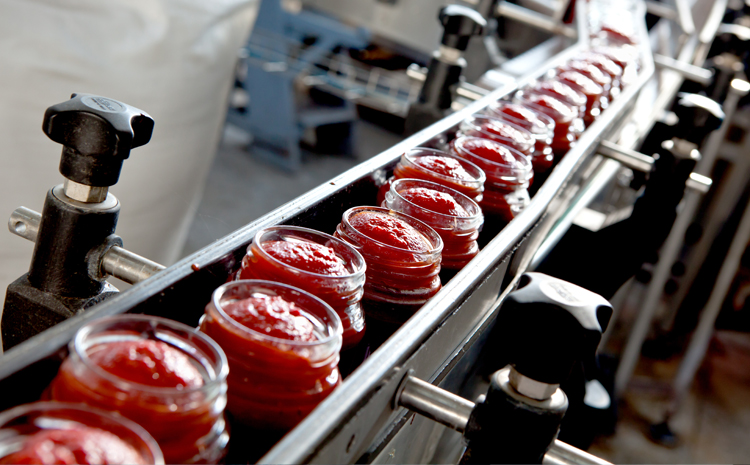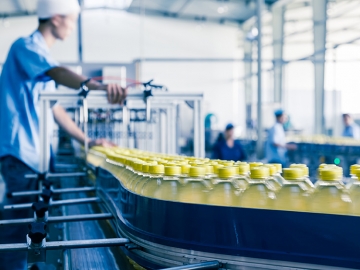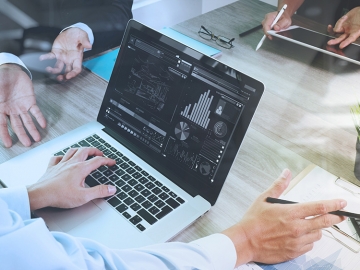Food Manufacturing

For the company’s manufacturing materials, semi-finished products and end products, regardless their type, TotalSoft has developed and provided the solution Charisma for Manufacturing, a set of modules specific to the industrial and agricultural manufacturing, perfectly integrated to Charisma ERP. Its features cover many types of manufacturing businesses, such as:
- Production by flow (Work Flow) –specific to the average and significant manufacturing, by technology sequential phases on a linear flow, such as grocery (obtained by slaughter, cutting, processing of meat), bakery products, dairy products, alcoholic products
Benefits
- Reduces the manufacturing time by product/order via native integration to the solution for manufacturing resource planning;
- Reduces manufacturing costs and optimises the supply activity;
- Increases the efficiency of the manufacturing process by planning the production depending on the customer orders, manufacturing capacities, as well as the proven performance, reporting of the performed and ongoing production, waste management and quality assurance;
- Optimises the manufacturing time by early identifying delays, permanent tracking and controlling;
- Increases the performance of the team directly involved in the production, thanks to the deeper understanding of the role and duties of the jobs by the company’s employees.
Features
- Tracks manufacturing by various dimensions and the orders during the manufacturing phases;
- Defines and efficiently tracks the technology structure – the company’s technology entities (technology groups depending on the technology operations systematically executed by technology phase for obtaining the semi-finished products and end products), capacities and manufacturing capabilities;
- Defines the products and the used technologies – hierarchically defines the products/projects (product/project hierarchy structure), defines the specific operations at each node level in the hierarchy structure (subassembly/project activity), standardizes the required execution times for each operation (preparation times, execution times, idle times, transportation times);
- In pre-calculation, calculates the pre-calculated cost of an offered or ordered product, based on the raw costs standardised in the technology (raw material, labour, equipment costs), overhead percentages set ad manufacturing department level and a hierarchy calculation model. The pre-calculated cost (hierarchically consolidated) is detailed by value at section overhead cost level, administrative overhead cost, pre/calculated profit quota, sales price, in a primary currency (RON) and a secondary currency (e.g. EUR, USD);
- Fully plans the manufacturing process by defining the manufacturing plans at various management levels, based on the sales plan, the estimated or firm customer orders;
- Allows recording the actual manufacturing or ongoing manufacturing, waste management and quality assurance;
- Tracks the manufacturing related costs by the allocation dimension with various meanings (order, product, product group, manufacturing sections, equipment, expense type/calculation item);
- In post-calculation, calculates the raw and burden costs at the end of the accounting period (month) (by section, enterprise) at direct cost center level (order, product) and calculation item (expense type: labor, raw material, material, depreciation, services, etc.); the burden costs are allocated from the indirect cost centers (sections, auxiliary departments, administrative) to the direct cost centers in multiple steps, based on configurable allocation keys;
- Allows multiple profitability analysis at accounting period and direct cost centre level (order, product), depending on the specific manufacturing type:
- Pre-calculation – post-calculation comparison – detailed verification at direct cost centre level (order, product) and calculation item, of the pre-calculated costs (based on the standardised consumption of raw material and resources such as personnel, equipment) versus the actual costs (based on the expense documents affecting the balance sheet class 6);
- Revenue – Expense comparison – checking at direct cost center level (order, product) the actual revenue (based on the revenue documents affecting the balance sheet class 7), of the direct expenses (based on the expense documents affecting the balance sheet class 6) and overhead (allocated during the post-calculation) and the actual profit




